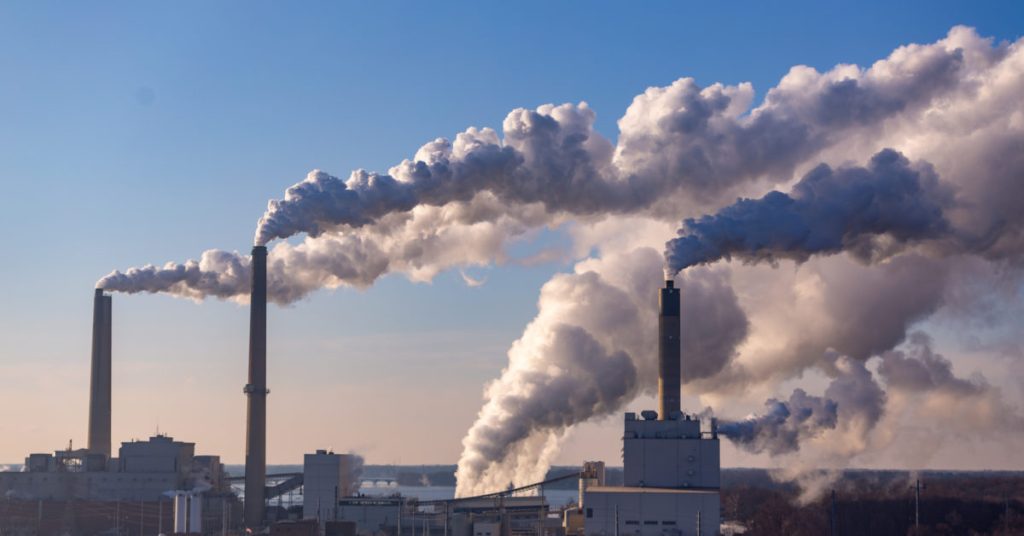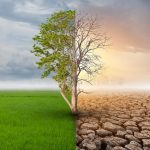Air pollution occurs due to the presence of undesirable solid or gaseous
particles in the air in quantities that are harmful to human health and environment. It can be defined as presence of foreign matter either gaseous or particulate or combination of both in the air which is detrimental to the health and welfare of human beings.
Pollutants that are emitted directly from identifiable sources are produced by natural events can be in the form of particulate matter or gaseous form. These are called primary pollutants Ex: Dust storms and volcanic eruptions and through human activities like emission from vehicles, industries etc. There are five primary pollutants that contribute to 90% of global air pollution. These are 1)carbon oxides (CO & CO2), 2)N oxides, 3) sulphur oxides, 4) volatile organic compounds and 5) suspended particulate matter. The pollutants that are produced in the atmosphere, when certain chemical reactions take place among the primary pollutants and with others in the atmosphere are called secondary air pollutants. Eg: Sulphuric acid, nitric acid, carbonic acid and acid rain. Particulates are small pieces of solid material. Particulate matter can be 1) Natural such as dust, seeds, spores, pollen grains, algae fungi, bacteria and viruses 2)
Anthropogenic such as mineral dust, cement, asbestos dust, fibers, metal dust, fly ash smoke particles from fires etc.
Causes of Air pollution:
Air pollution may originate from one or more variety of sources. The natural pollution include sources such as oceanic aerosol, volcanic emissions, biogenic sources, wind blown terrestrial dust and lightening. The artificial pollution generates from human activities and includes sources such as fuel burning, refuge burning, transportation, construction of buildings, chemical factories, metallurgical factories and vehicles.
The third category includes solvent usage and sources include spray painting and solvent extraction. Automobiles are the first rate of polluters. Industries occupy second position.
Effects of Air Pollution:
i. Effects on human health: Particulates cause carcinogenic effects, accumulate in lungs and interfere with ability of lungs to exchange gases. Prolonge0.0 exposure causes lung cancer and asthma. Cigarette smoking is responsible for greatest exposure to carbon monoxide (CO). Exposure to air containing even 0.001% of CO for several hours can cause collapse, coma and even death. As CO remains attached to heamoglobin in the blood for a long time, it accumulates and reduces the oxygen carrying capacity of blood. This impairs thinking, causes headaches, drowsiness and nausea. SO2 irritates the respiratory tissues. NO2 can irritate lungs, aggravate asthma and susceptibility to influenza and common colds. Many volatile organic compounds (benzene and formaldehyde) and toxic particulates can cause mutations and cancer.
ii. Effects on plants: Gaseous pollutants enter the leaf pores and damage the leaves of crop plants, interfere with photosynthesis and plants growth and reduces nutrient uptake and causes the leaves to turn yellow, brown or drop off altogether.
iii. On materials: Air pollutants break down the exterior paint on cars and houses.
iv. Effect on stratosphere: The upper stratosphere consists of considerable amounts of ozone, which works as an effective screen for UV light. This region is called ozone layer, which extends up to 60km above the surface of the earth. Ozone is a form of oxygen with 3 atoms instead of 2. It is produced naturally in the atmosphere. Presence of certain pollutants can accelerate the break down of ozone. Depletion of ozone effects human health, food productivity and climate as given below.
a. Effects on human health: Sun burn, cataract, aging of skin and skin cancer are caused by increased UV radiation. It weakens the immune system by Volcanic emissions supporting the body’s resistance to certain infections like measles, chickenpox & other viral diseases.
b. Effect on Food Production: UV radiation affects the ability of plants to capture light energy during the process of photosynthesis. This reduces the nutrient content and growth of plants mostly in legumes and cabbage. Plants and animals are damaged by UV radiations.
c. Effects on climate: Contribute to global warming, a phenomenon which is caused due to the increase in concentration of certain gases like CO2, NO2 methane and chloroflorocarbons (CFCs).
Control measures: Two approaches
1. Preventive technique
2. Effective control
Effective means of controlling air pollution is to have proper equipments in place. This includes devices for removal of pollutants from fuel gases through scrubbers, closed fuel collection recovery systems, the use of dry and wet collectors, filters, electrostatic precipitators etc.
Using unleaded petrol for vehicles is another way of control. The substitution of raw materials that cause more pollution with those that cause less pollution. Building higher smoke –stacks facilitate the discharge of pollutants as far away from the ground as possible. Industries should be carefully located so as to minimize the effect of pollution after considering topography and wind directions.
TABLE 1 AMBIENT AIR QUALITY STANDARDS IN INDIA BY THE CENTRAL POLLUTION CONTROL BOARD
| Area Category | SPM μg/m3 | SO2 μg/m3 | CO μg/m3 | NOX μg/m3 |
| Industrial & mixed use | 500 | 120 | 5000 | 120 |
| Residential and rural | 200 | 80 | 2000 | 80 |
| Sensitive | 100 | 3 | 1000 | 30 |
Case study on environmental impact of Iceland volcanic eruption
The air traffic disruption caused by the iceland volcano eruption in 2010 highlighted the environmental impacts of atmospheric dust from volcanic eruption. The volcanic ash, in effect pulverized rock, was spewed between 20,000 to 40,000 feet into the atmosphere right where modern aircraft ply their trade. This atmospheric dust not only hinders visibility but can also damage aircraft engines, forcing them to shut down completely. The fact that this disruption is not only affecting the countries of Europe, but has a knock on effect on all worldwide flights that have a European destination.
Volcanoes can spew atmospheric dust and gases tens of kilometers into the earth’s atmosphere where prevailing winds can very quickly transport them thousands of kilometers from the original eruption. Volcanic ash can lower visibility in the upper atmosphere and knock out aircraft engines. Widespread ash from volcanic eruptions increase the Earth’s “Albedo Effect”, cooling the temperature of the lower troposphere while increasing the temperature of the stratosphere. Volcanic activity is estimated to be responsible for the release of 130 million tonnes of carbon dioxide into the atmosphere annually. Sulfur dioxide, a major ingredient of volcanic activity, is the primary cause of environmentally damaging acid rain. It also forms sulfuric acid mists which causes pulmonary damage to both people and animals. Hydrogen sulfide, a colorless gas with an offensive odor, causes irritation of the upper respiratory tract and pulmonary edema. Atmospheric dust from volcanoes can act as a magnet for other pollutants and water vapor, giving rise to atmospheric hazes and heavy fogs.


